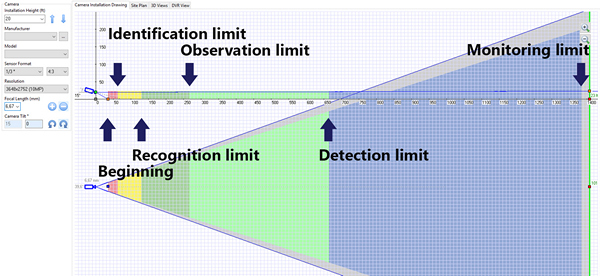Identification of features in both video and photograph (still image) recordings depend on the level of pixel density.
Pixel density for Camera Sensors
Marketing and advertising is pushing consumers towards higher pixel counts for the video and cameras they sell. CCTV cameras with less than 6MP (6million pixels) are becoming harder to find with 6MP and 8MP becoming standard.
However, the sensor sizes are not increasing and in some cases are getting smaller. While this has some benefits of much finer detail being captured for a given distance and focal length in daylight. They fall woefully short when they are needed the most i.e. Night time recordings are near useless unless the scene is well lit. This is due to the increasingly smaller sensor pixel bins which in turn result in a smaller dynamic range that cannot cope with the darker environments.
If you want a CCTV camera that works well at night, choose a 2MP, or 4MP at most. Also ensure that the sensor size is around 1/3inch or 1/2.8inch. The larger the sensor size, the larger the pixel bins for a given pixel count.
Pixel density of a CCTV recording is referred to as Pixels Per Metre (PPM) whereas pixel density for a sensor or monitor is referred to as Pixels Per Inch (PPI) or Pixels Per Centimetre (PPCM). Pixel density is calculated by dividing the camera horizontal resolution by the lens field of view width. The field of view width can be calculated by
The density of pixels relates to how many sensor pixels are able to record the features of the object (person, vehicle, etc.) at a given distance and is typically stated as pixels per metre (horizontal). As distance increases, pixel density decreases exponentially. A doubling of distance will quarter the pixel density. If a person’s face is only being “painted” by a 4 x 8 pixel grid, then you will never get any facial features captured to enable identification.
Pixel Density Requirements
The available pixel density determines whether the video or photograph can be used for:
- Identification – requires 250 PPM (or 4mm per pixel) to positively identify a person beyond reasonable doubt.
- Recognition – requires 125 PPM (or 8mm per pixel) to recognise a known person with a high degree of certainty.
- Observation – requires 62 PPM (or 16mm per pixel) to observe characteristic details like distinctive clothing.
- Detection – requires 25 PPM (or 40mm per pixel) to detect a human presence.
- Monitoring – requires 12 PPM (or 80mm per pixel) to perform crowd control and general movements.
A factor that can impact and over-ride these pixel density levels is the amount of compression applied to the recorded image(s).
The more compression, the more fine detail is lost which cannot be recovered when using a lossy compression algorithm.


